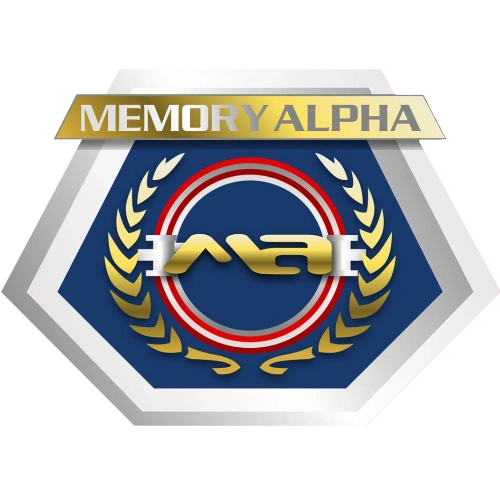|
Ten artykuł jest właśnie poddawany intensywnej rozbudowie. Poniżej znajduje się treść medalowego artykułu Anglojęzycznej Wersji Memory Alpha. Jeśli chcesz wspierać rozwój Polskiej Wersji Memory Alpha pomóż przetłumaczyć go na język polski! Zobacz też inne tłumaczone strony oraz Pomoc dla tłumaczy. |
| Klasa Constitution Oryginalna konfiguracja | |
| USS Enterprise w oryginalnej konfiguracji | |
| USS Enterprise w oryginalnej konfiguracji | |
| Przynależność: | Federacja Gwiezdna Flota |
| Typ: | ciężki krążownik |
| W służbie: | 2240s - 2270s |
| Długość: | 289 metry |
| Pokłady: | 21 |
| Załoga: | 205 (2250-), 430 (2260-) |
| Prędkość: | Warp 6 (maksymalna bezpieczna) Warp 8 (maksymalna) Warp 9 (wymagająca dużego ryzyka) Warp 11 (osiągalna z modyfikacjami silnika Kelvana) Warp 14.1 (osiągalna przez kilka minut przy przeciążeniu silników) |
| Uzbrojenie: | Baterie fazerów, 6 przednich wyrzutni torped fotonowych oraz rufowa wyrzutnia torped |
| Obrona: | Osłony |

| |
| USS Enterprise nowej konfiguacji | |

| |
| Schemat przekroju klasy Constitution | |
| Klasa Constitution Nowa konfiguracja | |
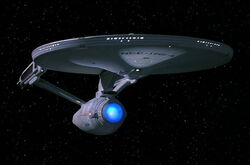
| |
| USS Enterprise-A, odnowiona klasa Constitution | |
| Przynależność: | Federacja, Gwiezdna Flota |
| Typ: | Ciężki krążownik |
| Długość: | 305 metrów |
| Pokłady: | 23 |
| Załoga: | 432 (2270-), później 500 (2290-) (The Undiscovered Country) |
| Prędkość: | Warp 8 (maksymalna przelotowa) Warp 9 (awaryjna) |
| Uzbrojenie: | 18 emiterów fazerowych, 2 wyrzutnie torped fotonowych |
| Obrona: | Deflektor i osłony |
Klasa Constitution, znana również jako klasa Starship1 lub Ciężki krążownik I klasy, były najważniejszymi pierwszoliniowymi okrętami Gwiezdnej Floty w drugiej połowie 23 stulecia. Zaprojektowano je do odbywania długich misji z minimalnym zewnętrznym wsparciem, a najbardziej znane są z ich sławnych misji eksploracyjnych i dyplomatycznych, które z reguły trwały do pięciu lat.
Historia[]
W 2267, we flocie służyło około dwanaście3 statków klasy Constitution. (TOS: „Tomorrow is Yesterday”) W skład tej grupy wchodziły NCC-1700, USS Constellation, USS Defiant, USS Enterprise, USS Excalibur, USS Exeter, USS Hood, USS Intrepid, USS Lexington, oraz USS Potemkin.
Najsławniejszym okrętem tej klasy był USS Enterprise (NCC-1701), wypuszczony pod dowództwem kapitana Roberta Aprila w 2245. Enterprise zyskał swoją reputację podczas historycznej pięcioletniej (2265-2270) pod komendą kapitana Jamesa T. Kirka. (VOY: „Q2”)
W 2266, daty gwiezdnej 1709, Enterprise przyczynił się do zapobiegnięcia wojnie pomiędzy Federacją a Imperium Romulańskim. Kiedy Romulański Drapieżny Ptak przekroczył Strefę Neutralną i zniszczył szereg posterunków przystrefowych, kapitan Kirk ledwo przechytrzył wrogiego dowódcę i powstrzymać jego statek przed powrotem na Romulusa i poinformowaniu o słabości Federacji.(TOS: „Balance of Terror”)
Parametry misji dla tej klasy oznaczają, że statki zwykle są rozproszone i samotne, a spotkania siostrzanych jednostek rzadkie. Aczkolwiek w 2267 duża ich ilość spotkała się przy Bazie Gwiezdnej 11 w celu odnowienia i napraw. (TOS: „Court Martial”)
Pomimo sukcesu tej klasy okrętów, widocznego na przykładzie okrętu Kirka, misje okrętów klasy Constitution były również często niezwykle niebezpieczne, co pociągało za sobą względnie wysokie straty i czyniło z nich jednostki dużego ryzyka. Na przykład, w 2267 USS Constellation pod dowództwem komodora Matta Deckera padł ofiarą czegoś, co stało się znane jako "Doomsday machine", podczas rutynowej misji ratunkowej koło układu L-374. Oba statki, oraz cała załoga, zostały stracone. (TOS: „The Doomsday Machine”) Podobnie, i niecały rok później, w 2268, USS Intrepid z załogą Wolkan stracono wraz z całą załogą podczas fatalnego zdarzenia z ogromną amebą kosmiczną w układzie gwiezdnem Gamma 7A w sektorze 39J. (TOS: „The Immunity Syndrome”) Nieco ponad rok później, USS Exeter został zainfekowany nieznanym wirusem, pozostałością po działaniach wojennych, mających miejsce na Omega IV, a wokół której orbitował statek. Wirus ponownie zabił całą załogę, z wyjątkiem kapitana Ronalda Traceya. Nieuszkodzony, ale zarażony statek pozostawał przez pewien czas w dryfie. (TOS: „The Omega Glory”)
W późnym 2268, Excalibur, Hood, Lexington, i Potemkin wzieły udział w katastrofalnym teście komputera M-5, który zamontowano, aby kontrolował Enterprise. Excalibur został poważnie uszkodzony i stracił niemal całą załogę. Lexington również został brutalnie napadnięty przez komputer, gdy stał się niestabilny. (TOS: „The Ultimate Computer”) Ponad rok później, Defiant odpowiedział na sygnał alarmowy z niezbadanej strefy w kosmosie, będącego terenem roszczeń Tholian Assembly. Wkrótce po wkroczeniu w rejon, załoga Defianta doświadczyła zaburzeń sensorycznych, a po statku rozprzestrzeniło się szaleństwo. Lekarz nie był w stanie określić, co się dzieje, a szaleństwo spowodowało, że członkowie załogi wymordowali się nawzajem.
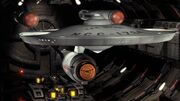
Defiant w Tholiańskim suchym doku
Trzy tygodnie później, Gwiezdna Flota nakazała Enterprise rozpoczęcie misji poszukiwawczej, w celu odnalezienia Defianta. Daty gwiezdnej 5693.2, Enterprise zlokalizował go dryfującego, zagubionego pomiędzy wszechświatem a przestrzenią warp. W wyniku późniejszej wymiany ognia z fazerów pomiędzy Enterprise a tholiańskimi jednostkami, w przestrzennej interfazie powstała dziura, przez którą Defiant dostał się do wszechświata równoległego. (TOS: „The Tholian Web”)
Nieznany historii "głównego" wszechświata, Defiant pojawił się w 22-gim stuleciu równoległego wszechświata, w którym Tholianie stworzyli ryft międzyfazowy, detonując trójkobaltową głowicę bojową w studni grawitacyjnej martwej gwiazdy. (ENT: „In a Mirror, Darkly”) Defiant przypuszczalnie odegrał główną rolę w rządach Hoshi Sato nad Ziemią. (ENT: „In a Mirror, Darkly, Part II”)
Fizyczny układ[]
| Plik:Constitution class forward.jpg | 
|
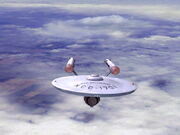
|
Plik:Enterprise impulse drive 2265.jpg |
Klasa Constitution charakteryzuje się układem sekcja spodka - sekcja maszynowni - gondole warp, wspólnym dla większosci okrętów Gwiezdnej Floty. Wszystkie statki tej klasy, na tym samym poziomie ulepszeń, na pierwszy rzut oka wydają się identyczne. Dopiero bliższa inspekcja ujawnia małe detale, odróżniające je od siebie. (TOS: „The Cage”, „The Ultimate Computer”; Star Trek I; etc.)
W oryginalnej konfiguracji klasy, w głównym kadłubie znajduje się w sumie czternaście różnych laboratoriów naukowych (TOS: „Operation -- Annihilate!”). Po odnowieniu w 2270-, mesa oficerska była ulokowana w tylnej części pod mostkiem. (Star Trek I) Co najmniej siedem turbowind obsługiwało oba kadłuby - główny i maszynowy. (TOS: „The Man Trap”) Modularna konstrukcja pozwalała na separację komponentów w razie kryzysu. Kadłub główny i poboczny mogą się oddzielić w miejscu "karku", łączącego te sekcje, pozwalając każdej z nich posłużyć za łódź ratunkową, w razie zbyt dużego uszkodzenia drugiej. Jeżeli awaria ograniczałaby się do gondoli warp, istnieje teoretyczna możliwość odrzucenia ich, bez naruszania reszty kadłuba. Jednak jakakolwiek separacja kadłuba jest uważana za niebezpieczną i nie zawsze jest możliwa. (TOS: „The Apple”, „The Savage Curtain”)
Chociaż nie posiada aerodynamicznych kształtów, statek klasy Constitution może zejść z orbity i wejść w górną atmosferę planety klasy M (zachowując zdolność regulowania wysokości) na pewien okres czasu, zależny od zdolności statku do ponownego osiągnięcia prędkości ucieczki. (TOS: „Tomorrow is Yesterday”)
Historia modyfikacji[]
USS Enterprise - wczesna konfiguracja modułu mostka w 2265
Od 2254, lub wcześniej, do 2265 statkiu klasy Constitution posiadały duży talerz deflektora, dużą, półsferyczną wypustkę na mostek oraz wystajće anteny na kolektorach Bussarda, na czubku każdej gondoli. Napęd impulsowy miał w 2254 dwa wyloty, oraz do 8 mniejszych w 2265. (TOS: „The Cage”, „Where No Man Has Gone Before”)
Gdzieś pomiędzy 2265 a 2266, stary talerz deflektora został zastąpiony znacznie mnejszym, usunięto wyoustki na kolektorach Bussarda, zamontowano mniejszą i bardziej płaską kopułę nad mostkiem, tylne końce gondoli wyposarzono w sferyczne dodatki, a napęd impulsowy posiadal odtąd tylko dwa duże wyloty. (TOS: „The Corbomite Maneuver”)
Wnętrze korytarzy, mostku i sali odpraw również zostało przeprojektowane gdzieś pomiędzy 2254 a 2265. Zainstalowano też nowe interkomy.
W 2266, ponownie zmieniono wnętrze korytarzy i kompletnie przeprojektowano salę odpraw. Mostek otrzymał powiększony ekran główny, oraz usprawnienia interfejsów kontroli oraz oprzyrządowania stanowisk, ale całość pozostała względnie niezmieniona w porównaniu z rokiem 2265. (TOS: „The Corbomite Maneuver”)
Kwatery załogi z 2254 mogły pomieścić nieco ponad 200 ludzi. (TOS: „The Cage”) W konfiguracji z 2266 mogły pomieścić załogę w liczbie ponad 400. (TOS: „Charlie X”)
| Plik:Refit Constitution class forward.jpg | Plik:USS Enterprise refit, aft.jpg |

|
Plik:USS Enterprise-A refit, profile view.jpg |
Od późnyh lat 2260- do wczesnych 2270-, okręty klasy Constitution przeszły ostatni znany znaczny program odnowy. Zajmował on 18 miesięcy, przez które na szkielecie starego statku de facto budowano nowy, wymieniając każdy większy podsystem. W tym stanie klasa Constitution kontynuowała służbę przez przynajmniej kolejne dwadzieścia lat.
Znaczące zmiany wprowadzono do systemów warp. Stare, cylindryczne gondole zastąpiono graniastymi, a ich połączenie z kadłubem znajdowało się odtąd znacznie bliżej karku. Kadłub maszynowni zachował w ogólności oryginalny kształt. Przedtem był on kształtu czysto cylindryczno-stożkowego, po modyfikacji stał się bardziej zaokrąglony.
Talerz defektora został unowocześniony, zrywając z architekturą talerza "satelitarnego". Powiększeniu legł też hangar i lądowisko dla promów. Dodano poziomy reaktor materii-antymterii, oraz pionową komorę mieszania.
Nowością było również zainstalowanie na karku statku prostokątnej, podwójnej wyrzutni torped fotonowych. Zmieniono również konfigurację fazerów, które pobierały energię przez rdzeń warp. Co więcej, znacznie powiększono sekcję spodka (prawie 20 metrów), podczas, gdy reszta powierzchni pozostała praktycznie bez zmian.
Znaczne zmiany zaszły we wnętrzu. Dodano wiele nowych systemów, a dotychczasowe unowocześniono. Podsumowując, odnowienie w latach 2270- przetrwać mogła tylko wewnętrzne struktura spodka, niewielka część kadłuba maszynowni oraz karku. (Star Trek I)
Niektóre konfiguracje po odnowie posiadały gondole warp obrócone o 90 stopni i miały dodatkowe włazy po obu stronach spodka. (TNG: „Booby Trap”)
Układy sterowania i kontrolni[]
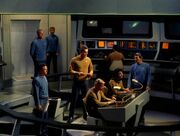
|
Plik:Constitution class bridge (2267).jpg |
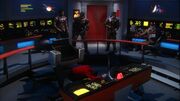
|
Plik:Constitution class bridge console.jpg |
Główne centrum dowodzenia klasy Constitution, mostek główny, ulokowany był na szczycie kadłuba ŋłównego, na pokładzie 1. Stąd oficer dowodzący nadzorował cały statek.
Fotel dowodzenia ulokowany jest we wgłębieniu pośrodku pomieszczenia, bezpośrednio naprzeciw głównego ekranu. Lokacja ta jest w równej odległości od wszystkich konsoli kontronych. Dzieki temu kapitan może być natychmiast powiadamiany o stanie stanie statku lub załogi, a wydawanie rozkazów jest łatwe. Fotel jest obrotowy, na czworokątnej płycie przymocowanej bezpośrednio do pokałdu, co daje znaczne oparcie w razie ataku. Dzięki obrotowości kapitan może obrócić się o dowolny kąt ku dowolnemuu członkowi załogi.
Funkcje pilotażowe i nawigacyjne świadczone są przez konsolę sternika, położoną pośrodku mostka, bezpośrednio przed fotelem dowódcy. Panel zawiera trzy główne sekcje.
Pol ewej znajduje się przedział automatycznie otwierajacy się, by umożliwić operowanie na skanerze celowniczym. Obok znajduje się fłówny panel, zarządzajacy pędnikami manewrowymi, silnikami impulsowymi oraz ogniem. Bezpośrednio poniżej znajduje się rząd ośmiu przełączników do ustawiania prędkości warp.
Centralna sekcja konsoli dowodzenia obfitowała w kontrolki sensorów, oraz była zdominowana przez dwa główne elekenty: sygnalizator alarmów i astrogator, używany do wyznaczania dalekich kursów. Stanowisko nawigacyjne posiada panel kontrolny do wprowadzania kursu, heading data oraz wskaźnik trasy, dostarcza również informacji na temat odchyleń i poprawek kursu. Posiada również kontrolę uzbrojenia.
Inne stanowiska na mostku służą komunikacji, sprawom technicznym, kontroli uzbrojenia, kontroli grawitacji, kontroli uszkodzeń, ustawieniom środowiska, nauce oraz dostepowi do bazy danych komputera oraz bezpieczeństwa wewnętrznego. Zwykle wszystkie są obsługiwane non stop.
Whłębienie na przodzie mostka mieści główny ekran. Czujniki wizualne umieszczone w różnych punktach zewnętrznego kadłuba klasy Constitution pozwalają na stosowanie przybliżeń i wielu kątów patrzenia.
Układy komputerowe na pokładzie klasy Constitution były deuteronowe. (TOS: „The Ultimate Computer”; DS9: „Trials and Tribble-ations”)
Unowocześnienia[]
| Plik:Enterprise bridge wide, TAS.jpg | Plik:Constitution class refit bridge 1.jpg |
| Plik:Constitution class refit bridge 2.jpg | Plik:Constitution class refit bridge, 2293.jpg |
W oryginalnej konfiguracji klasy Constitution, mostek obsługiwała tylko jedna turbowinda. W późnych latach 2260-, cześć statków została odnowiona z dodaniem drugiej windy w lewej przedniej sekcji mostka. (TAS: „Beyond the Farthest Star”) Po gruntownym odnowieniu we wczesnych latach 2270-, mostek klasy Constitution dalej posiadał dwie turbowindy, ale obie były ulokowane za fotelem dowódcy. (Star Trek I)
Na przestrzeni wielu lat służby, mostek klasy Constitution przeszedł wiele drobnych i dużych zmian kosmetycznych. W szczególności, mostek główny USS Enterprise podlegał znacznym zmianom w wyglądzie. W późnych latach 2260-, oprócz dodania turbowindy, projekt mostku zmienił się z segmentowego, podzielonego na płaskie panele, na w pełni okrągły, włączając w to zakrzywione górne ekrany, oraz odpowiednio zakrzywione poręcze i schody. W tym samym czasie dodano automatyczny system obrony mostku, który zajął przezroczystą kopułę nad mostkiem, która wróciła dopiero na statkach klasy Galaxy. (TAS: „Beyond the Farthest Star”) Był to początek znacznych zmian, na które składała się uaktualniona struktura, oraz pełne uaktualnienie układów wraz z przebudową we wczesnych latach 2270-. (Star Trek I)
Od tego momentu mostek przeszedł tylko niewielkie modyfikacje, aż do zniszczenia statku w 2285. Mostek USS Enterprise-A, oddanego do służby rok później (w 2286), miał w momencie startu głównie kosmetyczne różnice, ale w 2287 został drastycznie unowocześniony, zgodnie ze stopniem zaawansowania technologii komputerowej. Moduł mostka został ponownie zastąpiony w 2293. Lżejszy schemat kolorów mostka oryginalnego Enterprise-A został zamieniony na ciemniejszy, bardziej militarny. (Star Trek II: Gniew Khana; Star Trek IV: Powrót do Domu; Star Trek V: Ostateczna Granica; Star Trek VI: Nieodkryta Kraina)
Układy napędowe[]
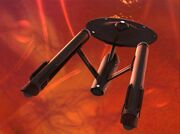
Oryginalna konfiguracja, widok od rufy.
W czasie swojej służby, statki klasy Constitution zaopatrzono zarówno w litowy, jak i dylitowy obwód reaktora w systemie napędu warp. Prędkością przelotową jednostek była warp 6, podczas, gdy prędkością maksymalną była warp 8. Warp 9 również była osiągalna, jednak jej użycie było niebezpieczne.
USS Enterprise był dwukrotnie modyfikowany, aby osiągać prędkość warp 11. W roku 2267 sonda Nomad zwiekszyła wydajność silników o 57%, pozwalając na osiągnięcie tej prędkości, jednak kapitan Kirk przekonal sondę do cofnięcia tych "napraw", ponieważ struktura statku nie mogła znieść tak dużej mocy i groziło jej zniszczenie. (TOS: „The Changeling”)
Szerze modyfikacje zostały przeprowadzone w 2268 przez Kelvansa, który był w stanie nadać statkowi prędkość daleko wykraczającą poza naukę Federacji, umożliwiając Enterprise bezpieczne przemieszczanie się z prędkością przelotową warp 11. (TOS: „By Any Other Name”)
Największą prędkość zarejestrowaną dla tej klasy okrętów była warp 14,1, osiągnięta przez Enterprise na skutek sabotażu napędu warp. Chociaż statek nie był przystosowany do przebywania w takiej prędkości przez najmniejszy nawet okres czasu, utrzymał ją przez prawie 15 minut. (TOS: „That Which Survives”)
Nowa konfiguracja, zbliżenie na silniki impulsowe.
Enterprise zachował również stabilność przy prędkości warp 22, będąc ciągniętym przez statek idący w warp 32. (TAS: „The Counter-Clock Incident”)
Po przebudowie w latach 2270-, klasa Constitution była wyposarzona w liniowy reaktor MARA (Matter-Antimatter Reactor Assembly - Reaktor Materii-Antymaterii), kontrolowany przez dwulit. W połowie lat 2290- na pokładzie USS Enterprise zainstalowano pulsową instalację kontrolowaną dwulitem. (Star Trek II: Gniew Khana; Star Trek VI: Nieodkryta Kraina)
Napęd impulsowy klasy Constitution stanowiły dwa bliźniacze silniki, zdolne rozpędzić statek do przynajmniej warp 0,8. (Star Trek I) Przeciążenie silników mogło poskutkować ekslozją termojądrową odpowiadającą 97,835 megatonom. (TOS: „The Doomsday Machine”)
Główna maszynownia[]
| Plik:Constitution original engineering2.jpg | Plik:Constitution original engineering.jpg |
| Plik:Warp core TAS.jpg | Plik:Main engineering, dilithium chamber.jpg |
| Plik:Constitution class refit engineering.jpg | Plik:Constitution Engineering.jpg |
Główna maszynownia była miejscem, z którego kontrolowano napęd warp. Wszystkie układy napędowe i energetyczne były kontrolowane przede wszystkim stąd. Tu również znajdował się reaktor na kryształach dwulitu. układy podtrzymywania życia kontrolowano osobno z pokładu 6. (TOS: „The Ultimate Computer”, „The Corbomite Maneuver”, „The Naked Time”, Day of the Dove)
Podczas przebudowy klasy Constitution w latach 2270-, wnętrze maszynowni zostało drastycznie odmienione, zyskując pionowy rdzeń warp i poziomą komore mieszającą.
Główna maszynownia znajdowała się na pokładach 14 i 15. Pokład 14był najwyższym pokładem kadłuba maszynowego, i był miejscem zakotwiczenia łącznika karkowego oraz pylonów gondoli warp.
Na przednim końcu pokładu znajdowało się pomieszczenie komputera monitorującego, otaczające wał komory mieszającej i otwierające się z tyłu na wnękę komputerów maszynowni.
Pokład 15 mieścił pomieszczenie głównej maszynowni. Pośrodku znajdowała się pionowa, liniowa komora mieszająca, rozciągająca się na wiele poziomów. Konstrukcja ta, będąca radykalnie nowym projektem w technologii mieszania, dostarczała mocy do napędu impulsowego oraz zaopatrywała w energię całą resztę statku.
Materia oraz antymateria dla komory mieszającej przechowywane były w szeregu komór magnetycznych, umieszczonych u podstawy tuby komory mieszającej. (Star Trek I)
Układy taktyczne[]
Systemy laserowe i fazerowe[]

Strzał przednimi fazerami na USS Enterprise
Podczas wczesnych lat 2250-, klasa Constitutionzostała wyposażona w komplet kierowanej broni energetycznej, posiadającej dość mocy, aby w skoncentrowanym bombardowaniu zniszczyć pół kontynentu. Dodatkowo jednostki posiadały na pokładzie działa laserowe, zdolne do zdalnego zasilania energią poza statkiem. (TOS: „The Cage”, „The Menagerie, Part I”, „The Menagerie, Part II”)
W 2266, baterie fazerów były standardowym wyposażeniem klasy Constitution. Bateria składała się z pojedynczego emitera i jego źródła zasilania, chociaż powszechną praktyką było strzelanie dwoma bateriami na rz i określanie tego mianem jednego strzału. (TOS: „The Corbomite Maneuver”, „The Doomsday Machine”, „The Paradise Syndrome”)
Okrętowe baterie fazerów posadały zasięg około 90 000 km. Podobnie, jak fazery ręczne, miały one możliwość konfiguracji na ogłuszanie, podgrzewanie i dezintegrację celów, zarówno obiektów w kosmosie, jak i na powierzchni planet. Dostrajaniu podlegał także stopień skupienia wiązki. Gdy tylko dostępne są odczyty czujników ruchu, fazery można ustawić na konkretne koordynaty celu. (TOS: „Balance of Terror”, „A Piece of the Action”, „Who Mourns for Adonais?”)
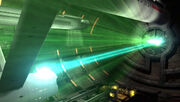
Okręt klasy Constitution, w oryginalnej konfiguracji, USS Defiant, strzelający tylnymi fazerami na kadłubie drugorzędnym.
W oryginalnej konfiguracji, baerie szeregu przednich emiterów fazerowych ulokowane były na dolnej części brzusznej strony spodka. Tylne baterie znajdowały się nad lądowiskiem promów na kadłubie drugorzędnym. Były również fazery lewoburtowe, prawoburtowe oraz centralne. (ENT: „In a Mirror, Darkly, Part II”; TOS: „Balance of Terror”, „The Paradise Syndrome”, „Arena”).
Odnowiona jednostka Constitution strzela przednimi fazerami.
Po przebudowie w 2270-, statki klasy Constitution posiadały trzy podwójne baterie fazerów na grzbietowej, i trzy na spodniej stronie spodka. Pokrywały one ogniem przód i flanki. Nad lądowiskiem promów znajdowały się dwie pojedyncze baterie tylne, a w części środkowej kadłuba maszynowego były koljene cztery emitery. Moc emiterów zwiększono przez pobór energii bezpośrednio z napędu warp. Owo zwiększenie mocy posiadało skutek uboczny, gdyż fazery zostałyby unieruchomione w wypadku awarii głównego reaktora. Problem ten spotkał USS Enterprise przynajmniej przy dwóch okazjach, raz w 2270s i ponownie w 2285. (Star Trek I; Star Trek II: Gniew Khana) Szablon:Clear
Układy torpedowe[]
Wyrzutnia torped (oryginalna konfiguracja)
Klasa Constitution posiadała pierwotnie sześć dziobowych tub torpedowych i tubę rufową, do odpalania torped fotonowych. Dziobowe tuby ulokowane były w tym samym miejscu, co przednie baterie fazerów. Tuba pokrywająca tylny kąt ostrzału wystrzeliwała torpedy z końca kadłuba drugorzędnego. Ten kombinowany arsenał był dostatecznie silny do zniszczenia powierzchni całej planety. (TOS: „Arena”, „A Taste of Armageddon”, „Journey to Babel”; TAS: „More Tribbles, More Troubles”; ENT: „In a Mirror, Darkly, Part II”)
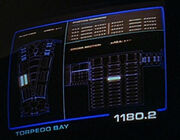
Manifest torped (odnowiona konfiguracja)
Wyrzutnia torped (odnowiona konfiguracja)
Jednostki po odnowieniu posiadały dwie przednie wyrzutnie torped, chociaż każda tuba mogła strzelać dwiema torpedami, przed załadowaniem kolejnych. (Star Trek II: Gniew Khana; Star Trek III: W Poszukiwaniu Spocka)
Osłony[]
Wyświetlanie statusu osłon
Okręt klasy Constitution posiadł w 2260- silne osłony. Siatka osłon została podzielona na cztery segmenty, do których odnoszono się "osłona nr jeden", "osłona nr dwa" etc. (TOS: „Journey to Babel”, „Elaan of Troyius”) Przy pełnej mocy, z reaktorem warp przekierowanym na system osłon, możliwe jest zaabsorbowanie i odepchnięcie bombardowania odpowiadającego eksplozji 360 torpedom fotonowym typu, jaki Enterprise miał na pokładzie w owym czasie, zanim osłony całkowicie by zanikły. Na przykład w 2267, Enterprise przetrwał atak sondy Nomad. Nomad strzeliła czterema silnymi pakietami energii, z których każdy odpowiadał 90 torpedom fotonowym. Pierwsze uderzenie zredukowało osłony tylko o 20%. Po uderzeniu siłą 270 torped fotonowych, utracono moc do manewrowania warp. Osłony opadły przy czwartym trafieniu. (TOS: „The Changeling”)
Siatka osłon była znacznie bardziej wrażliwa na standardowe bombardowanie fazerowe. W 2268 statek zwiadowczy Oriona był w stanie nadwyrężyć niektóe z osłon Enterprise po zaledwie pięciu przelotach. W siódmym podejściu Enterprise stracił jedną z czterech sekcji osłon. (TOS: „Journey to Babel”) Inne, potężniejsze bronie, mogły zdjąć osłony jeszcze łatwiej. Na przykład niszczyciel planet mógł zupełnie wyczerpać osłony statku klasy Constitution zaledwie trzema trafieniami wiązki antyprotonów. (TOS: „The Doomsday Machine”)
Przekierowanie całej mocy, z wyjątkiem zasilania awaryjnego, do osłon daje uboczny efekt zredukowania mocy fazerów o połowę. (TOS: „The Tholian Web”) Pojedyncza detonacja głowicy jądrowej bliżej niż sto metrów powoduje wewnętrzne przeciążenie na statku i przedostanie się promieniowania przez osłony do zewnętrznych sekcji statku. (TOS: „Balance of Terror”) Bez zasilania osłon reaktorem warp, system nie jest bardzo wydajny. Mając do dyspozycji jedynie reaktor impulsowy, klingoński krążownik bojowy klasy D7 może wyczerpać osłony statku klasy Constitution zaledwie kilkoma salwami z dyzruptorów. (TOS: „Elaan of Troyius”)
Po odnowieniu, w latach 2280-, okręty klasy Constitution potrzebowały 13,5 sekundy do opuszczenia i podniesienia osłon przy przyjmowaniu promu przy pomocy wiązki holowniczej. Lecąc promem ręcznie można było ten czas znacznie skrócić. (Star Trek V: Ostateczna Granica) Podczas żółtego alarmu, aktywowane były pola obronne do podstawowej ochrony głównego mostka. (Star Trek II: Gniew Khana)
Transportery[]
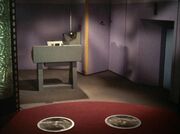
|
Plik:Constitution original transporter.jpg |
| Plik:Constitution transporter.jpg | Plik:Constitution class refit transporter.jpg |
Extravehicular transporter to and from the ship was accomplished by a number of transporter systems, which allowed personnel or equipment to be transported over large ranges. The transporter platform featured six pads, which were numbered clockwise, beginning with the right front. A redesigned field generator matrix was mounted into the rear wall of the chamber aboard the refit configuration Constitution-class starships.
Aboard the refitted Constitution-class vessels, the transporter operator stood within an enclosed control pod, which had a floor-to-ceiling transparent aluminum panel through which he or she could view the transport platform. This panel served to shield the operator from the effects of any cumulative radiations emitted by the new transporter machinery, a side effect of the more powerful system.
A door in the standard transporter room wall led to a staging area where landing parties prepared for transporter.
Śluzy[]
Airlock staging area in the 2270s
Refit Constitution-class starships possessed a number of airlocks permitting direct physical access to the ship. One was located at the aft of Deck 1 on top of the saucer section. Two more were located in the lower saucer section, port and starboard, concealed by sliding hull plates. (Star Trek I)
These lower two are accessed through staging areas. Four spacesuit lockers line one wall; each containing one suit, providing enough to clothe a standard party of four. A small, locked arms cabinet held phasers; communicators, tricorders, translators, and outerwear were contained in a separate cabinet on another wall. (Star Trek I)
The next set of airlocks were located on the port and starboard sides of the torpedo bays. The final set were located on the port and starboard sides of the secondary hull at the midline. (Star Trek I; Star Trek II: Gniew Khana) These airlocks opened into the ship's main cargo bay. There was also a "gangway"-style airlock on the port edge of the saucer section. (Star Trek I)
Located on the upper surface of the saucer section of the refitted Enterprise were numerous small hatches used for entrance/egress during extra-vehicular activities. (Kirk, Spock, Decker, McCoy, and the Ilia probe use one of these hatches to leave the ship when they arrive at V'GerSzablon:'s "core".) (Star Trek I)
Lądowiska i ładownie[]

|
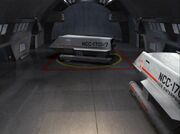
|
| Plik:Constitution class refit landingbay.jpg | Plik:Enterprise-A shuttlebay.jpg |
Deck 17 was the main access level of the engineering hull. The aft landing bay provided personnel in small craft with a means of entering or exiting the vessel, as did docking port on either side of the level.
The original configuration of the Constitution-class carried a standard complement of 4 shuttlecraft, some of which were Class F. (TOS: „The Omega Glory”)
The refit configuration Constitution-class starship featured a new landing bay design. A wide range of Starfleet and Federation craft could utilize this state-of-the-art landing facility. Alcoves on either side of the landing bay provided storage for up to six standard Work Bees, and furnished all necessary recharging and refueling equipment. Additional space was available for the storage of non-ship shuttlecraft.
Just within the landing bay doors was a force field generator unit, which was built into the main bulkheads on either side of the entry area. This field allowed craft to enter the ship, while at the same time retaining the atmosphere and temperature within the landing bay.
Deck 18, the refit configuration shuttlecraft hanger bay, was situated at the widest point of the engineering hull. Much of the deck consisted of open space, as it was the mid-level of the cargo facility; thirty-two cargo pod modules could be stored in the alcoves lining the forward, port, and starboard sides of the bay.
The shuttle hangar had sufficient room for the storage of four craft at any given time. During normal storage situations, these shuttlecraft faced aft.
This deck also housed the vessel's lifeboat facilities. These one-man craft, which escaped through blow-away panels in the side of the secondary hull, were provided for those persons were unable to reach the primary hull in case of an emergency. (Star Trek I)
Układy wsparcia załogi[]
Układy medyczne[]
Biobeds in sickbay
On the original Constitution-class starships, a sickbay facility was located on Deck 6, which featured an examination room, a nursery, the chief medical officer's office and a medical lab. At least one other medical lab was located elsewhere on the vessel, and was used for biopsy, among other things. Sickbay was considered the safest place to be on the ship during combat. (TOS: „The Naked Time”, „Elaan of Troyius”)
Intensive Care Unit on a refit configuration vessel
Refit configuration examination room
With the class refit of the 2270s, the medical facilities of the Constitution-class starship were considerably updated. New micro-diagnostic tables were capable of fully analyzing the humanoid body at the sub-cellular level, offering the physician a total understanding of the patient's status.
Another new addition was a medical stasis unit, in which patients whose conditions were considered immediately life-threatening could be placed into suspended animation until the proper cure or surgical procedure could be established. (Star Trek I)
Kwatery załogi[]
Crew quarters in the 2260s
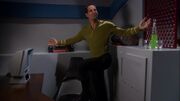
Senior officers's quarters on an original Constitution
Officers's quarters on a refit configuration Constitution
Crew quarters were located throughout the saucer section – keeping with Starfleet tradition, Deck 5 housed the senior officers' quarters. On the refit configuration vessels, these staterooms were quite similar to the VIP units on Deck 4, with only a few differences.
On starships of the original configuration, the officers' quarters featured two areas, separated partly by a wall fragment. One area was allocated as sleeping area, featuring a comfortable bed, and another as work area, including a desk and computer terminal. Entrance to a bathroom was provided through the quarter's sleeping area. Both areas could be configured to personal preference. (ENT: „In a Mirror, Darkly, Part II”; TOS: „The Enemy Within”)
On Constitution-class vessels, staterooms of the senior officers were composed of two areas which were separated by a retractable, transparent aluminum partition. The room's entrance opened into the living area. A library computer terminal and work desk were provided here. The room's corner circular nook, normally occupied by a dining booth, could be modified at the officer's request.
The other half of the stateroom was a sleeping area, which held a single large bed that could double as sofa during off-duty relaxation. A transparent door led into the bathroom area. By the 2290s, crew space was at a premium, and the size of officers' quarters was reduced to one large room and crewmen were housed in dormitories with bunk beds. (Star Trek I; Star Trek VI: Nieodkryta Kraina)
Rekreacja[]
A typical recreation room (2260s)
Recreation room (refit configuration, 2270s)
Aboard the original Constitution-class starships, there were at least six recreation rooms, which included three-dimensional chess and card game tables. There was also a holographic rec room, which was the predecessor of the holodeck. Also aboard were as arboretum, gymnasium, a bowling alley, a theater, and a chapel. (TOS: „Charlie X”, „The Naked Time”, „The Conscience of the King”; Star Trek I)
On the refitted Constitution-class vessels, recreational facilities were further expanded. One large room in the aft section of the starship's saucer section furnished off-duty personnel with a wide variety of recreational games and entertainment. At the front of the room was an immense, wall-mounted viewing screen. Beneath this was an information display alcove; five small screens exhibited, upon request, a choice of pictorial histories. A raised platform in the center of the lower level floor featured a diversity of electronic entertainment. (Star Trek I)
Officers' lounge[]
Officers' lounge privacy area on a Constitution-class vessel of the refit lineage
Located at the stern of Deck 2 aboard the refit configuration Constitution-class starship was the officers' lounge. Here, four huge view ports afforded a spectacular view of the ship's warp nacelles and space beyond.
To the sides, small plant areas held flora from several worlds and a small pool featured freshwater tropical fish. Just forward of this section of the lounge were two privacy areas. In each privacy area, a view screen was mounted into the wall, providing a full exterior tour of the vessel. (Star Trek I)
Statki oddane do służby[]
|
|
Dodatki[]
Zobacz również[]
- Constitution-class decks
- Szablon:Class
Wystąpienia[]
The Constitution-class Enterprise appeared in every episode of TOS and TAS (except for The Slaver Weapon). TOS episodes featuring other Constitution-class vessels besides Enterprise are listed below.
- TOS:
- Court Martial (remastered version only)
- The Doomsday Machine
- The Ultimate Computer
- The Omega Glory
- The Tholian Web
- Szablon:Star Trek films:
- TNG:
- The Naked Now (graphic display, refit)
- Lonely Among Us (model)
- The Battle (model)
- Hide and Q (model)
- Haven (model)
- The Big Goodbye (model)
- The Bonding (model)
- Booby Trap (model)
- The Best of Both Worlds, Part II (wreckage)
- The First Duty (model, original)
- Relics(bridge)
- DS9:
- Homefront (model)
- Paradise Lost (model)
- Trials and Tribble-ations
- What You Leave Behind (corridor in montage scene)
- VOY: „In the Flesh” (wall display, original and refit)
- ENT:
- In a Mirror, Darkly
- In a Mirror, Darkly, Part II
- These Are the Voyages...
Poza ekranem[]
Po więcej informacji o pochodzeniu oznaczenia klasy Constitution proszę zajrzeć pod: Przypis 1
Wnętrza[]
Po więcej informacji o układzie wnętrz Constitution, proszę zajrzeć pod: Scenografie klasy Constitution
Numer rejestrowy[]
Art Director Matt Jefferies was, apart from designing the ship, also responsible for conceiving its original, famous registry number "NCC-1701". As he explained, "Since the 1920's, N has indicated the United States in Navy terms, and C means 'commercial' vessel. I added an extra C just for fun. Interestingly, Russia's designation is CCC. So The N and C together made it kind of international. After that, I had to pick some numbers. They had to be easily identifiable from a distance, so that eliminated 3, 8 , 6, 9 and 4-none of which is that clear from a distance, That didn't leave much! So 1701 was as good a choice as any. The reason we gave for the choice afterwards was that the "Enterprise" was the 17th major design of the Federation, and the first in the series. 17-01!" (Star Trek: The Original Series Sketchbook, p. 62), "(...)which, incidentally and coincidentally, happens to be very close to the license number on my airplane-NC-17740. But I have never really stepped out and squashed the rumor that the number on the "Enterprise" came off my airplane." (Szablon:STTM)
Separacja spodka[]
A saucer separation capability for the Constitution-class was suggested as early as the second season of the Original Series in the original script of its episode The Apple, but was never produced for budgeting reasons. The capability was however envisioned by the producers, "Designed to operate separately from the rest of the ship, the saucer therefore contains all elements necessary for independent operation." (The Making of Star Trek, p. 171) The intent made it even into the official series' internal writer's guide, The Star Trek Guide (third revision, page 15 of the supplement and generally dubbed the "Writer's Bible"), where the saucer section was described to be "in fact a completely self-sustaining unit which can detach itself from the galaxy drive units and operate on atomic impulse power for short range solar system exploration." [1]
The original saucer separation intent was reconfirmed years later on two occasions, when efforts were underway to revitalize the live-action franchise. Production Illustrator for Star Trek: Planet of Titans, Ralph McQuarrie, stated on several of the concept drawings he had created for a newly conceived Enterprise, "The saucer of the Enterprise (which was detachable) ends up in the shroud. They meet the aliens and had a dramatic finale. These two images are of the Enterprise saucer in the shroud.(...)The disc of the Enterprise would separate from the rest of the ship to land on the surface of planets." [2] The sketches, McQuarrie referred to, of the independently operating saucer section, were published in The Art of Ralph McQuarrie (pp. 124-129). The second occasion occurred when Star Trek: Phase II Producer Robert Goodwin reported in a progress memo dated Szablon:D, "Meanwhile we're having a new model of the Enterprise constructed, with the added bonus of a saucer section which can separate from the engine nacelles, should such a maneuver be a necessary part of some story. This capacity of the Enterprise was described in The Making of Star Trek, although it was never utilized in the first series." (Starlog, issue 11, p. 39)

TMP saucer separation concept

TMP saucer separation concept
Yet another saucer separation sequence was envisioned by Andrew Probert in 1979 when script treatments for Phase IISzablon:'s successor, The Motion Picture, were in flux. During a lull in script development Probert came up with an alternative scene in which V'Ger releases a Klingon Szablon:Class battle cruiser. Upon re-materialization the Klingons true to their nature immediately attack the Enterprise. During the battle Kirk is forced to a perform a maneuver akin to that of William T. Riker in The Best of Both Worlds, Part II. Douglas Trumbull liked the idea and had Probert draw up color story-boards to show the sequence. Some of the story-boards were published in Szablon:STTM, and in The Art of Star Trek, pages 198-199. Probert's concept was not entirely a flight of fancy as the actual studio model, in line with Goodwin's prior memo annotation, was constructed in such a way that a saucer separation could be filmed if the need arose. (Star Trek: The Next Generation Companion, 3rd ed., page 9) Probert himself remarked in this regard, "The Enterprise was always designed to separate from the Engineering section. I knew about this when I did Star Trek: The Motion Picture. And if you look at the bottom of Kirk's Enterprise [note: original configuration], you'll notice two triangular items, which are two of the landing feet for the saucer. Regardless of whether it was Matt Jefferies' original intention or not, it's sort of the way that "Trekdom" or "Star Trek lore" has labeled those features. So taking my cue from that for Star Trek: The Motion Picture, I placed four landing legs in the bottom of the Enterprise and crated a very specific separation line on the dorsal." (Star Trek: The Next Generation USS Enterprise NCC-1701-D Blueprints, booklet, p. 8)
Rozmiary[]
| Plik:Constitution-class USS Enterprise NCC-1701 finalized plan views by Matt Jefferies.jpg | |
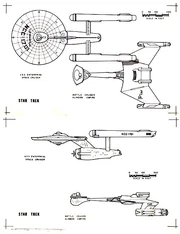
|
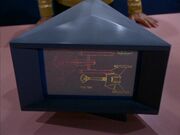 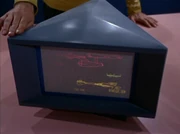
|
The dimensions of the Constitution-class, being 947 feet (289 meters) long for the original configuration and 1000 feet (305 meters) for the refit-configuration, have been set in stone in time immemorial as far as Star Trek -lore is concerned. That being said and oddly enough, neither dimension has actually ever been canonically confirmed, as neither dimension was ever seen or referred to in any of the live-action Star Trek productions.
The original configuration length of 947 feet was first derived from Stephen Edward Poe's reference book, The Making of Star Trek, p. 178, and that dimension has been propagated in every subsequent reference work ever since. However, what Poe did not mention was that designer Matt Jefferies had originally produced that graphic in 1967 as a reference for Poe's employer, model kit company Aluminum Metal Toys for their 1968 second edition retooled USS Enterprise model kit, no. S951 – where the graphic was displayed on the side of the box prior to its publication in the book – and not for the actual Original Series production. Remarkably, the dimension of the starship had been in flux until that time as a Producer Gene Roddenberry's memo of 24 August 1964 evidenced, "We anticipate a final design might see the ship as 200 feet in length, and thus even a 1½-inch scale would give us quite a huge miniature." This figure, initially accompanied with a crew complement of 203 would actually more or less stand until Jefferies, utilizing his engineering background, recalculated the figures for his design three years later. (The Making of Star Trek, pp. 89, 134)
The original configuration Constitution-class length came closest to canon, when two ship size comparison graphics were featured in the Original Series third season episode The Enterprise Incident. The two computer console graphics, also created by Jefferies, showed a Constitution-class vessel in comparison with a Romulan Szablon:Class battle cruiser and an in the episode barely discernible yardstick. Yet, careful measurement of the production art of the graphic, using the featured yardstick, measured the Constitution-class vessel actually at exactly 900 feet (274 meter). Jefferies later sold his original plan view design art, including that for AMT, in the Profiles in History The Star Trek Auction of 12 December 2001, in order to raise funding for the "Motion Picture & Television Fund" charity.
Likewise, the 1,000 feet length of the refit-Constitution-class was never canonically established on screen either, instead generally gleaned from the 1991 reference book, Star Trek: The Next Generation Technical Manual, where it was propagated to the public at large. The Manual itself was based on the internal document Star Trek: The Next Generation Writers' Technical Manual in which Andrew Probert had provided dimensions for most of the more prominent Starfleet vessels until then established in the live-action franchise. Actually, Probert himself had in turn based his dimensions on the size comparison production art, Visual Effects Art Director Nilo Rodis had created for Star Trek III: W Poszukiwaniu Spocka, published in a Cinefantastique article (Vol 17 #3/4, 1987, p. 77) almost half a decade earlier, and where the size was in fact already disclosed for the very first time. This was not a whimsical act on Rodis' part; As that movie introduced a multitude of newly designed starships at once and since studio models were almost never build in scale to each other, visual effects compositors at Industrial Light & Magic needed some sort of a reference dimensional framework in order for them to take the ships' relative sizes into account, when editing their ship effects footage if more that one appeared in a shot, for the interior Earth Spacedock scenes in particular. By setting the refit-Enterprise at exactly 1,000 feet, Rodis used that ship as the yardstick against which all other ships were measured in the movie.
Modele studyjne[]
For information on the Constitution-class studio models, please see:
- Constitution-class model (original)
- Constitution-class model (refit)
Przypisy[]
| Plik:Constitution primary phaser.jpg | 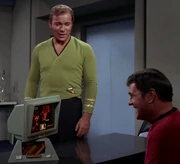
|
| Plik:Chief engineer Montgomery Scott examining a Constitution class diagram.jpg | |
1 Klasa "Starship": Jeśli przeczytać tabliczkę dedykacyjną na mostku oryginalnego Enterprise, okaże się, że jest on wypunktowany jako "Klasa Starship". Określenie "klasa Constitution" pochodzi ze scenariusza do epizodu TOS: „Space Seed”. Scenes 44 and 48 of the Second Revised Final Draft for "Space Seed," dated December 13, 1966 had the following content:
- 44 ANGLE ON SICK BAY VIEWER
- It is covered with mathematical symbols and diagrams. CAMERA PULLS BACK to show Khan studying with great concentration. He pushes a button. Another transparency appears: a chapter heading, reading: BASIC SPECIFICATIONS, CONSTITUTION CLASS STAR SHIP.
and,
- 48 INSERT - SCREEN
- A chapter heading: Basic Propulsion Systems, Constitution Class Star Ship.
That the scripted screen indicators indeed pertained to Kirk's ship followed from the prior conversation:
- "I was once an engineer of sorts. I would be most interested in studying the tech manual on your vessel. After all, I have two hundred years of catching up to do."
- "They are available on your viewing screen there. Dr. McCoy will show you how to hook into our library tapes."
- - Khan and Kirk, in the sickbay of the Enterprise
The graphic that was constructed for this script direction, but which was ultimately not used in the episode according to the influential "The Case of Jonathan Doe Starship" article by Greg Jein, published in the April 1973 issue 27 of the T-Negative fanzine, did make its first canon appearance in the second season episode The Trouble with Tribbles, as an otherwise unreadable graphic of a technical journal on a computer screen that Scotty was reading, showing a phaser bank diagram for a "Constitution-class" starship. The graphic was actually created by Art Director Matt Jefferies, who used his own extensive aviation library as his source. Depicted were two varieties of hydraulic fluid reservoirs, used by the US Air Force at the time. [3] The graphic was endowed with a caption, gleaned by Jein for his article after he had obtained a trimmed clipping from Lincoln Enterprises showing the graphic in its entirety, that read,
- PRIMARY PHASER L, R
- STAR SHIP MK IX/01
- CONSTITUTION CLASS
While this scripted reference was "understood" to have established the Enterprise belonging to the Constitution-class ever since by production staffers and fans alike, it was not until 1982 that the designation started to seep into canon. Authors of reference works such as Franz Joseph's Star Fleet Technical Manual were privy to scripts' contents, and to the fact that Enterprise herself was Constitution-class, even though it had never been mentioned in dialog or been readable on screen. Drawings from the aforementioned Technical Manual with the class name appeared on screen, again unreadable, in The Wrath of Khan and The Search for Spock. These were the first occasions a canonical production assigned the Constitution name to the class designation of the Enterprise. The Voyage Home assigned this class name to the refit-Enterprise as well, although some production staff previously and, apparently, unofficially called that design Szablon:Class, which actually was utilized, and discernible, for the Mark IV bridge simulator seen in The Wrath of Khan. The name Enterprise-class was also used in reference to the refitted Enterprise and the Enterprise-A in Mr. Scott's Guide to the Enterprise, though that particular reference book is neither considered canon nor "official". (Szablon:STTM)
The first time it was actually referred to as such in dialog, was by Captain Jean-Luc Picard in the first season episode The Naked Now of Star Trek: The Next Generation, which was followed by the first firm visual, clearly legible, confirmation in the form of the heading of a blueprint Scotty was examining in The Undiscovered Country, firmly establishing the fact in canon and concurrently dispelling any Enterprise-class notion definitively, as this blueprint also clearly noted his ship as a Constitution-class vessel. The designation has been mentioned several times and been more prominently visible in later series and episodes referencing ships of the Original Series and movies design. In the Star Trek: Enterprise episode "In a Mirror, Darkly" the dedication plaque of the USS Defiant (NCC-1764) clearly stated that she belonged to the Constitution-class (In the original third season episode The Tholian Web, the plaque, which was of course EnterpriseSzablon:'s, could not be seen due to deliberate camera angles). Not being one of the ships listed in the original final names list as reproduced in The Making of Star Trek (p. 165), used by the production team of the series, and although not being canon, this strongly suggested two things according to Greg Jein; Firstly, Starfleet changed its nomenclature from Starship-class to Constitution-class during the run of the Original Series-era (nicely tying in with Scotty keeping abreast by reading technical updates for the ship he is working on), and secondly, the Defiant belonged to a later batch of Constitutions (supported by the fact she has the highest registry number of all the definitively established Constitutions). Commissioned somewhere during the Original Series-era, she therefore had an unfortunately short career, at least in Star TrekSzablon:'s prime universe, or as Jein had succinctly put it, "Tough break". [4]
Szablon:Anchor2 The launch date of the class has never been established, but the reference book The Making of Star Trek stated on page 203 that the producer's intent was that the "Enterprise-class starships have been in existence for about forty years." Its author Stephen Whitfield, who had full access to production sources, wrote the book during the production of season two, narrowing the class launch window down to the mid-2220s. Interestingly, this meant that the Enterprise was a relative latecomer into the class, as its launch year was generally understood, but not firmly established, to be 2245 by production staffers and as was propagated in numerous reference books afterwards. Greg Jein in his article also proceeded from this understanding, and taking his cue from the "MK IX/01" annotation in the aforementioned technical journal graphic, postulated the ship to be of a newer "MK IX" subclass, with the USS Constitution (NCC-1700) as its (sub-)class vessel, in the process trying to make sense of the lower registry numbers by postulating them to belong to older sub-classes. Jein postulated the Enterprise as the second MK IX subclass member, hence the justification of the "01" addition to both the registry "NCC-17" and the technical journal graphic as seen, the reasoning adopted by the original registry designer, Matt Jefferies, as he himself had stated above. [5]
Szablon:Anchor3 There may only be twelve Constitution-class ships as of the first season episode Tomorrow is Yesterday, but the line this was drawn from ("there are only twelve like it in the fleet") has given rise to speculation that the Enterprise should be excluded from the count, meaning there could be thirteen Constitution-class ships as of that date. The twelve ship assertion was actually supported by production sources, as The Making of Star Trek (pp. 163, 203) clearly stated that, as far as the production staff was concerned, the intent was that there were twelve operational ships of the class foreseen for the second season by the time of its production, the Enterprise included and taking into account the two ships, USS Valiant and USS Farragut, already established as being destroyed in the first season episode A Taste of Armageddon, and already foreseen as mentioned destroyed in the second season episode Obsession, respectively. Kirk's statement then neatly corresponded with the twelve ship assumption; two, the Farragut and Valiant, presumed destroyed before the remark, with the USS Constellation (in "The Doomsday Machine", and already accounted for by D.C. Fontana in her memo version, though it was still in operation at the time of "Tomorrow is Yesterday" canonically) and USS Intrepid (in "The Immunity Syndrome") being destroyed after the remark. It should be noted that the inclusion of the Valiant was a late addition and that it was not even considered in the first two proposals. This, canonically speaking at least, constituted somewhat of a conundrum, an observation not lost on Greg Jein, as he had noted that the ship in question was already destroyed in 2217, whereas the Constitutions only became operational a decade later as far as was established by the producers. [6] While another, new ship would have made more sense, the intent of the producers was clear, the class was retro-applied to the lost ship. Yet, the twelve ship statement only held true under the supposition that the Defiant – not foreseen by the producers – had not yet been commissioned, which is open to debate; otherwise, and this was implied by the fact that the ship was already fully operational less than a year later, the thirteen ship number became valid.
After some corresponding with suggestions to and fro, the definitive name list of vessels belonging to the, then still called Starship-class, was agreed upon by the producers (dutifully carried over to the decal sheet of AMT's 1968 re-issue USS Enterprise model kit) at the start of the series' second season, and comprised the following vessels (The Making of Star Trek, pp. 164-165):
|
D.C. Fontana's[1] proposal 8 August 1967
|
Bob Justman's[2] proposal 9 August 1967
|
Definitive list as utilized at the start of TOS Season 2
|
- remarks:
- ↑ Aside from the remarks behind several of the names, Fontana further annotated on her memo,"Alternates include the names of some famous fighting ships of the past, plus a couple of international variations we might consider, Star Fleet being composed of a united service."
- ↑ Justman noted in his memo, "I think there would be several other candidates, such as Saratoga and perhaps another English carrier, a French carrier, a Russian carrier and certainly a Japanese carrier [note: though the ultimately chosen Kongo was in reality a World War I and II -era Japanese battleship, as were the British HMS Hood and Russian Potemkin, whereas, with the exception of the Excalibur and the Endeavor, all other by Justman proposed names were those of World War II aircraft carriers, the Constellation being an at the time recent US post-war carrier]. In addition, I think a name ought to be made up that would be of Vulcan origin [note: though not adopted, some of Justman's notion was carried over to having the Intrepid a crew that was almost entirely composed of Vulcans]."
Szablon:Anchor4 Certain ships: While most of these ships were already confirmed as class member in the Original Series, even more emphatically reaffirmed in its 2006-2008 remastered version, the classification of others was more tentatively derived. The "NCC-1707" was only identified by a Constitution-class icon in two display panels created for The Voyage Home, whereas the Eagle, Korolev, Emden, Endeavour, and Ahwahnee, with their respective registry numbers, were likewise all derived from the Operation Retrieve mission charts artwork, seen in the Star Trek VI: The Undiscovered Country (Special Edition) DVD, where they too were represented by Constitution-class icons. Michael Okuda, who created the mission charts, hinted at the fact they were intended to be of this class,
"If I recall correctly, the charts visible on film/video listed only ship names and registry numbers. One can probably glean some class designations from the ship icons in the diagrams. I don't have the original art handy (I think it's archived on Syquest disks, which I don't have the ability to read, even if I could find the disks themselves), but I recall giving the info to Bjo Trimble, and I'm pretty sure she used most of it in her revised Star Trek Concordance. I might note that some of the ship registry numbers came from Greg Jein's interpretation of the starship chart in Commodore Stone's office in "Shore Leave" (TOS). Other registry numbers came from Franz Joseph's Star Fleet Technical Manual or his Starship blueprints. In still other cases, the ships and/or numbers did not come from either source, but were consistent with some fleet status charts I did elsewhere on the Enterprise-A in Star Trek VI. (In other words, there's something that just about everyone will disagree with, but I also hoped that there would be at least something that almost everyone would agree with.) I should also point out that I prepared several charts for the rescue briefing scene, and that not all of them ended up in the final cut of the film. I don't recall which ones were used, or which ones ended up unseen. I do seem to recall that there was at least one chart that had quite a number of registries - mostly, I recall, from FJ's work - that ended up unused." [7]
Szablon:Anchor5 The Star Fleet Technical Manual lists the Defiant as NCC-1717, though the reference book has since then been considered non-canon and treated as apocryphal by the franchise. On-screen the ship was endowed with the registry number NCC-1764, though it was not discernible in its original appearance in "The Tholian Web".
- Registry numbers: Although the Star Trek Encyclopedia and other reference works provided complete registry numbers for many Constitution-class ships, these numbers were until 2006 at best conjecture. Many of the EncyclopediaSzablon:'s numbers were derived from Greg Jein's above-mentioned "The Case of Jonathan Doe Starship" article, which assumed that the list seen on the wall at Starbase 11 in Court Martial were all Constitutions. Yet, once the 2006 remastered version of the series came along, Michael Okuda made use of the opportunity to marry Jein's conjectural registry numbers, where applicable, to their respective ship names, thereby elevating conjecture to canon for those registry numbers, including that of the Defiant.
Szablon:Anchor6 Uncertain ships: These ships have been listed in various reference works as Constitutions, but were never canonically established on screen as such, and are therefore of uncertain class. There was another factor to consider - in the Original Series-era, ships that were identified as starships were automatically considered to be of the Starship-class ship, or in later reference works, the Constitution-type starship. This would account for the inclusion of the USS Carolina in this list, plus the unnamed ships from the Starbase 11 chart. The Farragut, Kongo, Republic, Valiant and Yorktown were from The Making of Star Trek, as discussed above.
Szablon:Anchor7 USS Yorktown: Gene Roddenberry suggested that the USS Enterprise-A was first designated as USS Yorktown, and later recommissioned as USS Enterprise-A, probably because Yorktown was the original name used in Roddenberry's 1964 proposal pitch to NBC. Roddenberry felt that it was very unlikely that a brand new ship would have been constructed so fast after the destruction of the original Enterprise. (Star Trek Encyclopedia, 3rd edition. p. 572) Had this became canon, the Yorktown would have been definitively been established as a Constitution-class vessel, which had been the intent of the Original Series producers in the first place. It would have also served as a convenient rationale why Scotty had so much trouble getting the ship into operational order in Star Trek V: Ostateczna Granica after the debilitating effects the Whale Probe inflicted on the ship in the previous outing. The notion of the re-naming was flat-out stated by Michael Okuda as being the case in his Star Trek: The Next Generation Writers' Technical ManualSzablon:'s (2nd edition, p. 6), somewhat toned down in his later published reference works, but emphatically reaffirmed in the even later officially endorsed Star Trek Fact Files and the 2010 reference book USS Enterprise Owners' Workshop Manual (p. 38 and on which Okuda served as the technical consultant). The Starfleet practice of renaming a vessel for a very deserving other vessel was later canonically established in Star Trek: Deep Space Nine, when the USS Sao Paulo was rechristened USS Defiant when the original latter was destroyed in the Dominion War. (DS9: „The Changing Face of Evil”, „The Dogs of War”)
- On a side note; The World War 2 aircraft carrier USS Enterprise (CV-6), after which Roddenberry named the NCC-1701, was a sister ship of the USS Yorktown (CV-5), belonging to the same Yorktown-class, the other one being the USS Hornet (CV-8), a name also considered by the aforementioned staff in an earlier draft of the names list. (The Making of Star Trek, p. 164) The three class sisters had their finest hour at the Battle of Midway in 1942, where they operated together, but where the Yorktown was lost. The Hornet and the Wasp (a scaled down variant of the Yorktown-class and another name considered by the producers) were lost later in the war, leaving the Enterprise the sole class survivor. Like its fictional counterpart, the historical Enterprise has become one of history's most celebrated vessels.
Apocrypha[]
Constitution-class registry[]
Although not considered canon, several sources have produced a long list of Constitution-class starships. The main source was Franz Joseph's aforementioned Star Fleet Technical Manual, which listed over one hundred Constitution-class ships divided into sub-classes: Constitution, Bonhomme Richard, Achernar, and Tikopai. Ships of the class were later expanded by other publications such as Ships of the Star Fleet which included the Endeavour, Enterprise, and Enterprise (II) subclasses. It should be noted that Joseph incorporated all the ship names the Original Series producers had originally proposed at the start of the second season.
- Constitution-class ships:
- USS Constitution (NCC-1700)
- USS Constellation (NCC-1017)
- USS Republic (NCC-1371)
- USS Enterprise (NCC-1701)
- USS Farragut (NCC-1702)
- USS Lexington (NCC-1703)
- USS Yorktown (NCC-1704)
- USS Excalibur (NCC-1705)
- USS Exeter (NCC-1706)
- USS Hood (NCC-1707)
- USS Intrepid (NCC-1708)
- USS Valiant (NCC-1709)
- USS Kongo (NCC-1710)
- USS Potemkin (NCC-1711)
- USS Bonhomme Richard (NCC-1712)
- USS Monitor (NCC-1713)
- USS Hornet (NCC-1714)
- USS Merrimac (NCC-1715)
- USS Endeavour (NCC-1716)
- USS Defiant (NCC-1717)4
- USS Excelsior (NCC-1718)
- USS Eagle (NCC-1719)
- USS Lafayette (NCC-1720)
- USS Wasp (NCC-1721)
- USS El Dorado (NCC-1722)
- USS Ari (NCC-1723)
- USS Saratoga (NCC-1724)
- USS Tori (NCC-1725)
- USS Krieger (NCC-1726)
- USS Essex (NCC-1727)
- USS Truxton (NCC-1728)
- USS Confiance (NCC-1729)
- USS Bunker Hill (NCC-1730)
- USS La Vengeance (NCC-1731)
- USS Achernar (NCC-1732)
- USS Sol (NCC-1733)
- USS Jupiter (NCC-1734)
- USS Rigel Kentaurus (NCC-1735)
- USS Quindar (NCC-1736)
- USS Proxima (NCC-1737)
- USS Androcus (NCC-1738)
- USS Astrad (NCC-1739)
- USS Mondoloy (NCC-1740)
- USS Alfr (NCC-1741)
- USS Thelonii (NCC-1742)
- USS Xanthii (NCC-1743)
- USS Sirius (NCC-1744)
Apocrypha appearances[]
- The Constitution-class was present in the alternate Star Fleet Universe, where it served as the backbone of Starfleet from its inception in the Y120s to the advent of the General War and the related deployment of the Chicago-class New Heavy Cruiser. In the Star Fleet Universe, the Constitution design is descended from the Republic-class cruiser, the first in that universe's Federation fleet to possess the saucer and nacelle configuration. (Some of the older ships were refitted into Constitution-class ships over time, while others became part of the Federation National Guard, protecting the major member worlds.) In time, the advent of more advanced technology resurrected the ship design through the Vincennes-class vessels, a parallel evolution to that seen in the change from the TOS-era Enterprise to the TMP ship design. Notably, a number of the ships referred to in the original series (such as the Hood and the Excalibur) or listed in the Technical Manual (such as the Kongo) are expanded upon in the Star Fleet Universe – but due to the licensing restrictions under which ADB operates, the Enterprise herself is not detailed, though her registry is included.
- A saucer separation has been depicted in the DC Comics Star Trek: Debt of Honor. Here Kirk used "explosive bolts" to sever the connection between the saucer module and the engineering section of the USS Farragut. The same trick was used again in the DC Comics Star Trek: The Mirror Universe Saga, where Kirk and his crew escaped the self-destruction of the ISS EnterpriseSzablon:'s engineering section in a last-minute separation. Another Constitution-class ship, the USS Confederate, was shown operating without its saucer section in Marvel Comics Star Trek Unlimited Issue 4; after the crew abandoned the engineering hull via saucer separation due to a failure in an experimental propulsion system upgrade. In the early drafts of Star Trek: The Motion Picture, the Enterprise was to separate the saucer. The 2006 Star Trek: Ships of the Line calendar includes a picture of a separated Constitution-class ship, engaging Klingons – or possibly a Klingon ship flown by the Romulans – in battle.
- Constitution-class vessels are prominently featured in fan film productions like Star Trek: Phase II, Starship Exeter, Starship Farragut, and Of Gods and Men.
- The refit version of the Constitution class was still in service in 2409 as a cruiser in the video game Star Trek Online (though the TOS configuration can be purchased into the game as well). The class has also inspired three 24th/25th century successors: the Excalibur, Vesper, and Exeter classes. The TOS configuration comes with retrofit fore and aft phasers, which are the TV-correct blue phasers. The Exeter class, which also can be purchased, comes with the ability to fire photon torpedoes which can hunt down cloaked targets.
Linki zewnętrzne[]
- Constitution-class w Memory Beta, obejmującą dzieła związane z uniwersum Star Trek
- Constitution-class, artykuł na polskiej Wikipedii.
- Szablon:Forgotten Trek - article on Matt Jefferies' design of the Enterprise for The Original Series
- Szablon:Datalink
- Szablon:Forgotten Trek - article on the design of the refit Enterprise for The Motion Picture
- Szablon:Datalink
- Szablon:Eas - analysis of the several modifications performed on the Constitution class
- Szablon:Eas
Szablon:Featured
